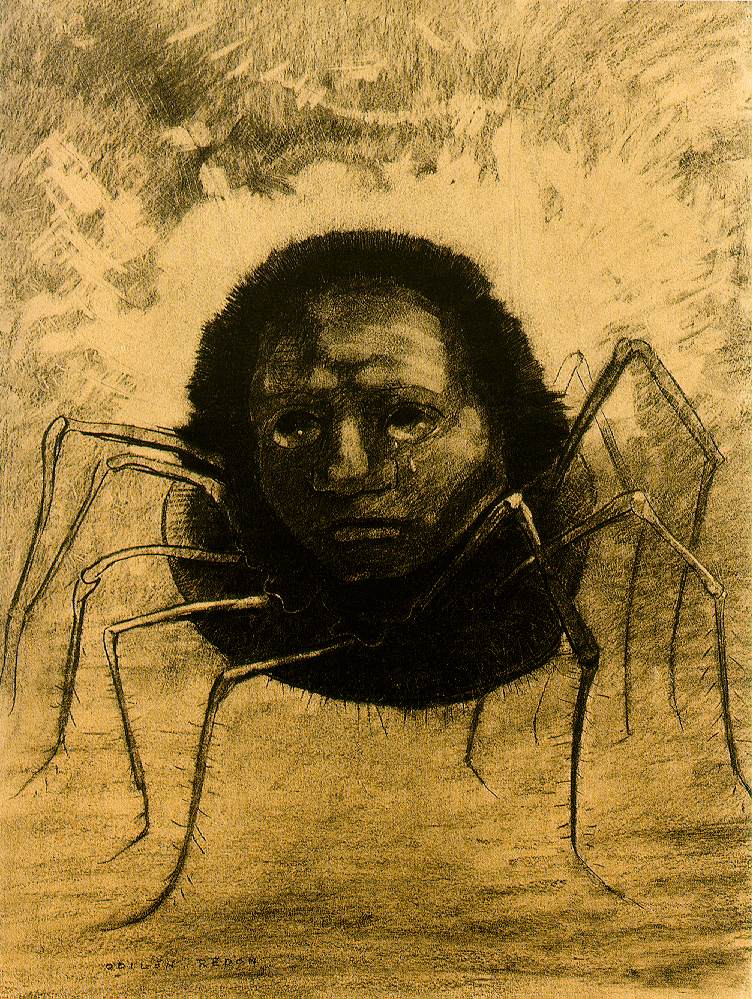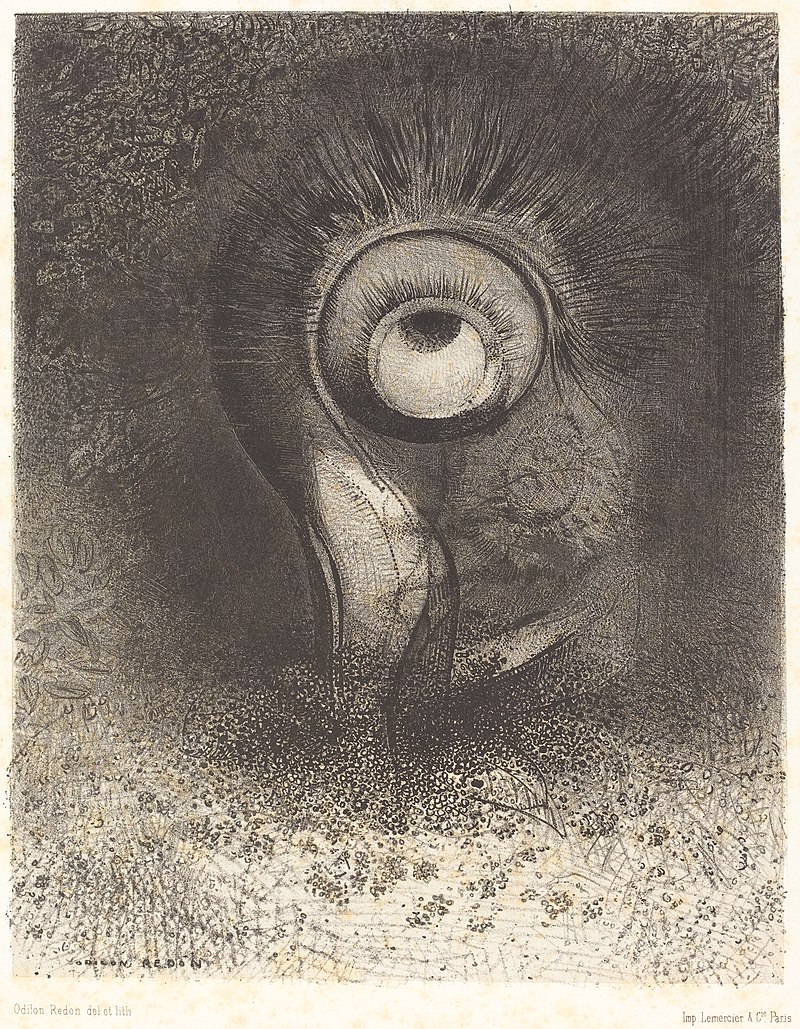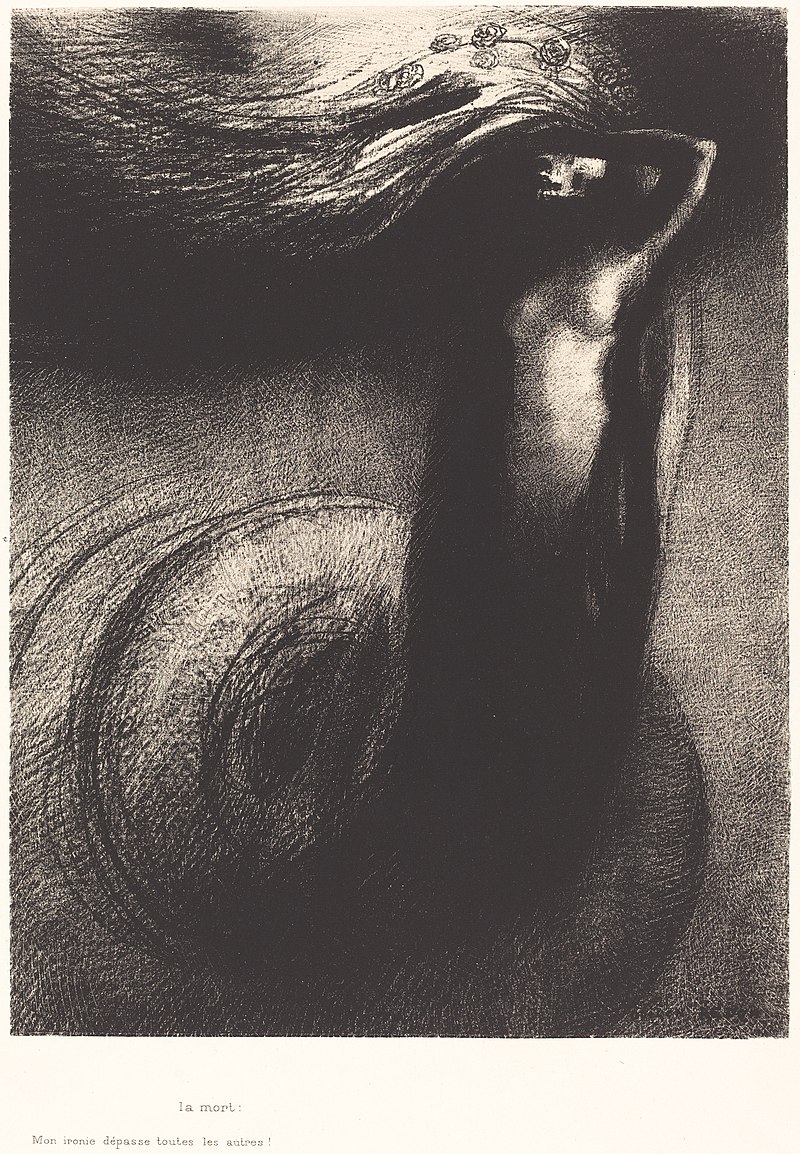28 Chapter 10 – Odilon Redon
Odilon Redon: Influence on Art History and Symbolic Artwork
Hailee Sharyk
Audio recording of chapter available here:
Well known for his symbolism and mysticism within his artwork, Odilon Redon, was born in 1840 in Bordeaux, France.[1] At just a mere 10 years old, Redon won a prize for one of his drawings, helping kickstart his creative mind and passion for art.[2] Redon began his career as an abstract and symbolist artist prior to the Franco-Prussian War; sculpting, drawing, and beginning to learn the process of etching and lithography.[3]

Then, in 1878, Redon joined the army to help fight in the Franco-Prussian War, putting a pause to his artistic endeavors.[4] It was not until many years after the war when Redon no longer served the army, did he begin to become recognized for his artwork, especially for his lithographic prints he referred to as the “Noirs”.[5] Redon greatly influenced art history through the use of his lithographs, and his unique perspective on life and art can also been viewed symbolically through his work.
Odilon Redon was not a traditional artist for his time. For his most famous work, Redon used etching and lithography techniques to publish his drawings known as “Noirs”, which was not a popular medium for artists to use in the 1880’s.[6] However, Redon’s use of this technique and his rise to popularity did influence the French art community to begin using lithography as a more common art medium. This method of copying his drawings allowed for the increased distribution of his artwork, allowing for an increased income and exposure to his artwork.[7] Not only did Redon use an uncommon technique for artists to recreate and redistribute his visions on paper, but the way he drew and constructed his Noir drawings were also unique as well. He only used the colour black, and he worked almost exclusively in charcoal.[8] By using only black, Redon was able to create images that held strong and intense emotions. Yet, by using the charcoal in soft and bold lines, he was able to tell a story through the contrast of the various lines and strokes.

Why did Redon choose on black for his lithographs?
Redon stated: “One must respect black. Nothing prostitutes it. It does not please the eye and it awakens no sensuality. It is the agent of the mind far more than the integral part of the artist’s fantasy.”[9]
In addition to using unusual techniques and colours, Redon created images that were symbolic by incorporating his own personal interests and inquiries into his creative imagery. With the advances of empirical enquiry within the sciences, and new concepts like astrophysics replacing old ideals in 1860, things within society were ever-changing and unpredictable.[10] Redon was attracted to the invisible and unknown forces of the world, man’s lack of understanding or control over these forces, and the implications it could have on himself and humanity.[11] His curiosity brings acknowledgement to the metaphysical world, the cosmos, mythological stories, nodes to Buddhism, consciousness, and even Christianity.[12] When presenting these ideas and themes within in his work, he does so in an almost simplistic, but unassuming way. The time and attention spent to detail did not lie in his brushstrokes, but in the meanings behind the strokes. Although his artwork is not simple in its construction, Redon does not find the need to draw extremely realistic drawings with many details. He uses the basic building blocks to get an idea or story across. The image itself seems simple in comparison to the grandiose feelings he can communicate in fewer brushstrokes than most artists of his time.

Around the 1870’s, Redon began to explore the cosmological and spiritual side of life throughout his artwork when the mystery and mysticism of Symbolist’s work was at its height.[13] When discussing his own artwork, Redon describes it as “putting the logic of the visible to the service of the invisible” and uses his minds eye to create imaginary beings with material reason.[14] His artwork is not intended for the viewer to have a pleasant, enjoyable, visual experience, but for them to ignite a different framework of thought, contemplation, mystery, and curiosity instead. Redon often spoke about how his artwork did not obey the laws of life and nature, and he put his full self in his works and the creation of his monsters.
In Redon’s work, Dans le Reve: Germination (translates to: Germination from in The Dream), using only black and the contrast of the white paper, disembodied heads are pictured floating within a black abyss. Starting from a large portrait at the top of the print, then scaling down in size as they disperse throughout the dark space. This gives the lithograph a cosmological and atmospheric feeling, as well as a sense of melancholy. Yet, despite the melancholic energy the white and black contrast around the largest head and portrait gives it an illuminated, light feeling. When investigating the image closer, the eyes of the largest head look down upon the smaller, more skull-like faces. The skull-like faces have their eyes looking all about, leaving the viewer with a sense of confusion and chaos – they are unsure where to look. The floating heads may represent life, or one’s soul as they float around the unknown. Amongst the floating heads are smaller, white circles. These may be more floating heads or souls, or even stars. As a symbolist artist, this image could be a cosmological rendition of birth, life, and germination itself. Redon prided himself in “exploit[ing] mental imagery rather than [the] visual experience” and mentions that his drawings are meant to inspire others, not to define things.[15]

After 1900, Redon abandoned lithography for more abstract art with distinct colour palettes.[16] Although Redon almost exclusively drew in charcoal using only black, later in his life he began to take up painting and pastels.[17] At a first glance, the colours chosen seem almost out of place in comparison to traditional works of its time. However, with Redon’s symbolistic background, these colours are chosen and placed very articulately. He drew portraits of his wife and son, using splashes of colour that appear to be out of place in comparison to the rest of the image to show abstract emotions. Random spots of blue or orange in various corners can be seen in renditions of his family members.
![By Odilon Redon - [1], Public Domain, https://commons.wikimedia.org/w/index.php?curid=31781438 A wild bunch of flowers tumble from a blue vase in a splashing fan of colour across a neutral tan background.](https://upload.wikimedia.org/wikipedia/commons/9/95/Odilon_Redon_005.jpg)
Redon also had a collection of oil paintings just before he passed in 1916 of realistic vases of flowers.[18] These pieces really show how talented of an artist Redon was, that he was an artist who could “art” like no other artists from his lifetime. The symbolism Redon used embodied mystery; evoking intense emotions but leaving the “why” up to the viewer to figure out as the symbolism was never explicit. His diverse talents and spiritual outlook on life not only greatly influenced Redon’s work, but art history itself with his unique creatures and the use of lithographs as a mean of reproduction and distribution of his art.
To see Odilon Redon’s Dans le Reve: Germination from 1879 check out this webpage from the Museum of Modern Art:
Odilon Redon, Dans le Reve: Germination, 1879, lithograph with chine appliqué https://www.moma.org/audio/playlist/6/316
Bibliography
Conrad, Christian. “The Life and Art of Odilon Redon with Christian Conrad”, video, 24:00, May 7, 2021, www.youtube.com/watch?v=mApHYkN9oQo.
Enger, Reed. “The Crying Spider.” Obelisk Art History. Accessed September 19, 2021. http://arthistoryproject.com/artists/odilon-redon/the-crying-spider/.54
Larson, Barbara. “The Franco-Prussian War and Cosmological Symbolism in Odilon Redon’s ‘Noirs.’” Artibus et Historiae 25, no. 50 (2004): 127–38. https://doi.org/10.2307/1483791.
Lieberman, William S., and Odilon Redon. “Redon: Drawings and Lithographs.” The Bulletin of the Museum of Modern Art 19, no. 2 (1952): 3–15. https://doi.org/10.2307/4058189.
Redon, Odilon. 1840-1916. Crying Spider. Images, n.d. Accessed September 19, 2021. https://jstor.org/stable/community.13697044.
Redon, Odilon. “Dans Le Reve: Germination”. Accessed September 19, 2021. https://jstor.org/stable/community.13726129.
Seiferle, Rebbeca. “Odilon Redon Artist Overview and Analysis”, The Art Story, Accessed September 19, 2021, https://www.theartstory.org/artist/redon-odilon/.
[1] Rebbeca Seiferle, “Odilon Redon Artist Overview and Analysis”, The Art Story, Accessed September 19, 2021, https://www.theartstory.org/artist/redon-odilon/.
[2] Rebbeca Seiferle, “Odilon Redon Artist Overview and Analysis”.
[3] Seiferle, “Odilon Redon Artist Overview and Analysis”.
[4] Christian Conrad, “The Life and Art of Odilon Redon with Christian Conrad”, video, 24:00, May 7, 2021, www.youtube.com/watch?v=mApHYkN9oQo.
[5] Barbara Larson, “The Franco-Prussian War and Cosmological Symbolism in Odilon Redon’s ‘Noirs.’” Artibus et Historiae 25, no. 50 (2004): 127–38. https://doi.org/10.2307/1483791.
[6] Christian Conrad, “The Life and Art of Odilon Redon with Christian Conrad”, video, 24:00, May 7, 2021, www.youtube.com/watch?v=mApHYkN9oQo.
[7] Rebbeca Seiferle, “Odilon Redon Artist Overview and Analysis”, The Art Story, Accessed September 19, 2021, https://www.theartstory.org/artist/redon-odilon/.
[8] Reed Enger, “The Crying Spider.” Obelisk Art History. Accessed September 19, 2021. http://arthistoryproject.com/artists/odilon-redon/the-crying-spider/.54
[9] William S. Lieberman and Odilon Redon, “Redon: Drawings and Lithographs”, 3-15.
[10] Barbara Larson, “The Franco-Prussian War and Cosmological Symbolism in Odilon Redon’s ‘Noirs.’” Artibus et Historiae 25, no. 50 (2004): 127–38. https://doi.org/10.2307/1483791.
[11] Barbara Larson, “The Franco-Prussian War and Cosmological Symbolism in Odilon Redon’s ‘Noirs.’”.
[12] Christian Conrad, “The Life and Art of Odilon Redon with Christian Conrad”.
[13] William S. Lieberman and Odilon Redon, “Redon: Drawings and Lithographs,” The Bulletin of the Museum of Modern Art 19, no. 2 (1952): 3–15, https://doi.org/10.2307/4058189.
[14] Rebbeca Seiferle, “Odilon Redon Artist Overview and Analysis”, The Art Story, Accessed September 19, 2021, https://www.theartstory.org/artist/redon-odilon/.
[15] William S. Lieberman and Odilon Redon, “Redon: Drawings and Lithographs”, 3-15.
[16] William S. Lieberman and Odilon Redon, “Redon: Drawings and Lithographs”, 3-15.
[17] Christian Conrad, “The Life and Art of Odilon Redon with Christian Conrad”, video, 24:00, May 7, 2021, www.youtube.com/watch?v=mApHYkN9oQo.
[18] Christian Conrad, “The Life and Art of Odilon Redon with Christian Conrad”, video, 24:00, May 7, 2021, www.youtube.com/watch?v=mApHYkN9oQo.

